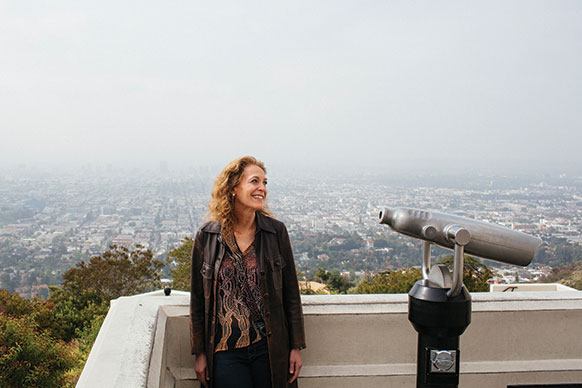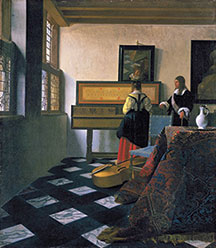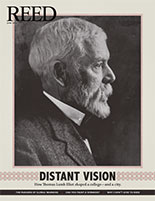
IRIS login | Reed College home Volume 93, No. 2: June 2014
Stroke of Genius

Farley at the Griffith Observatory in Los Angeles. Photo by Kendrick Brinson
Producer Farley Ziegler ’84 makes a documentary about one man’s quest to unlock the artistic secrets of Johannes Vermeer.
By Laurie Lindquist

The Music Lesson, also known as Lady at the Virginals with a Gentleman, by Johannes Vermeer ca. 1662–65. In Farley’s film, Texas inventor Tim Jenison attempts to reproduce this image by reverse-engineering Vermeer’s techniques.
The luminescent quality of Johannes Vermeer’s paintings has astonished viewers for 350 years. How did he achieve such incredible photorealism a century and a half before photography was invented?
That’s the question that drives the film Tim’s Vermeer, released this spring by Sony Pictures Classics and a high point of the 37th Portland International Film Festival. The documentary focuses on a Texas inventor named Tim Jenison, who is obsessed with figuring out—and duplicating—Vermeer’s secret techniques. The film has received numerous nominations and awards, including a 2014 BAFTA nomination for best documentary. For Farley Ziegler ’84, who produced the film in collaboration with the magical duo Penn and Teller, the project represents the consummate synthesis of art and science.
Jenison’s understanding of Renaissance artistic techniques—primarily the camera obscura—stemmed from David Hockney’s Secret Knowledge: Rediscovering the Lost Techniques of the Old Masters and Philip Steadman’s Vermeer’s Camera: Uncovering the Truth behind the Masterpieces. But many details about Vermeer’s particular methods and his life (1632–75) in Delft remained elusive.
Led by insatiable curiosity, Jenison proposed an experiment: if Vermeer achieved the exceptional quality of light and dimension that distinguishes his work by utilizing a machine, could a nonpainter employ the same technique and replicate a Vermeer?
Although Jenison had never held a paintbrush, he undertook the challenge. It was a “journey into obsession no one was prepared for,” says Ziegler. Through incremental stages, characterized by both failure and breakthrough, Jenison explored his hypothesis and transformed his theory. His obsession drove him to the point of physical and mental exhaustion, but he refused to give up until he had an answer—an unexpected discovery that defies the conventional wisdom about Vermeer.
Ziegler found a “wonderful boldness” in Jenison, who, being neither a painter nor an art historian, was able to view Vermeer’s work through a unique lens. “That he looked at the paintings differently, and, as a consequence, that they yielded different information, is so compelling!” It’s easy to stop looking and to stop asking questions when something seems apparent, Ziegler says. “Rigorous inquiry and the desire to challenge accepted modes of thought, rather than taking things at face value, track very closely with what I learned at Reed, or, more accurately, how I learned to learn at Reed.”
Describing herself as an ardent fan of the humanities, Ziegler majored in English at Reed, working with adviser Prof. Gayle Pemberton [English 1983–84] and Prof. Rick Gray [German 1982–83] to write her thesis on “The Mysteries and Manners of Eudora Welty.” She also recalls favorably the courses taught by Prof. Bill Lankford [English 1977–81], Prof. Robert Segal [religion & humanities 1975–81], and Prof. Peter Steinberger [political science 1977–]. A “late bloomer” in her undergraduate years, Ziegler possessed confidence, an appetite for learning, and an eagerness to participate fully in the classroom in courses she took later in life—first in New York, and later at the Getty Museum and with T.C. Boyle at the University of Southern California. “Much to my delight, my learning at Reed has turned out to be time-release.”
Ziegler worked as a marketing manager for Institutional Investor, writing and overseeing production of the magazine’s commercial, marketing, and advertising materials. Living in New York City, she took classes in playwriting at Playwrights Horizons, and then applied to and was accepted into the graduate program at Columbia University. At the same time, she had fallen in love and moved to Paris with her then boyfriend. “I could always go back to grad school later, whereas . . . Paris!” While overseas, she had the realization that in order to learn how to write, she simply needed to begin writing. “I did not need to go to school to do that.”
From Paris, she moved to Los Angeles and began a career in film as an assistant to director David Fincher at Propaganda Films. She was story editor and creative executive for director Sean Penn at Clyde Is Hungry Films. With Christina Ricci, she created and ran the production company Blaspheme Films. Ziegler served as Production Executive at Single Cell Pictures, bringing Being John Malkovich to the screen; as a collaborator on the National Public Radio series Joe Frank: In the Dark; and as a producer, with Penn Jillette, of the documentary comedy The Aristocrats.
During the seven months that it took Jenison to paint, Ziegler spoke with him every day through a video Skype feed. The intimate quality of the film comes directly from this communication. For the project, Ziegler also worked as a videographer; traveled with Jenison and the crew to England, Holland, San Antonio, and Las Vegas; and played an integral role in the editing done with Patrick Sheffield and Penn and Teller as they created an 80-minute story from 2,400 hours of film.
Though the project was initiated from the standpoint of science, the framework of the film is built on the human experience, says Ziegler. Jenison’s search to uncover a technique leads him into the presence of the artist who created it. It is a journey that will resonate with anyone who has engaged in and answered to the demands of intellectual pursuit. And for everyone there is an unexpected gift that results from viewing Tim’s Vermeer, Ziegler says. It is a surge of enthusiasm to follow one’s own passion—“and to never throw in the towel.”

LATEST COMMENTS
steve-jobs-1976 I knew Steve Jobs when he was on the second floor of Quincy. (Fall...
Utnapishtim - 2 weeks ago
Prof. Mason Drukman [political science 1964–70] This is gold, pure gold. God bless, Prof. Drukman.
puredog - 1 month ago
virginia-davis-1965 Such a good friend & compatriot in the day of Satyricon...
czarchasm - 4 months ago
John Peara Baba 1990 John died of a broken heart from losing his mom and then his...
kodachrome - 7 months ago
Carol Sawyer 1962 Who wrote this obit? I'm writing something about Carol Sawyer...
MsLaurie Pepper - 8 months ago
William W. Wissman MAT 1969 ...and THREE sisters. Sabra, the oldest, Mary, the middle, and...
riclf - 10 months ago